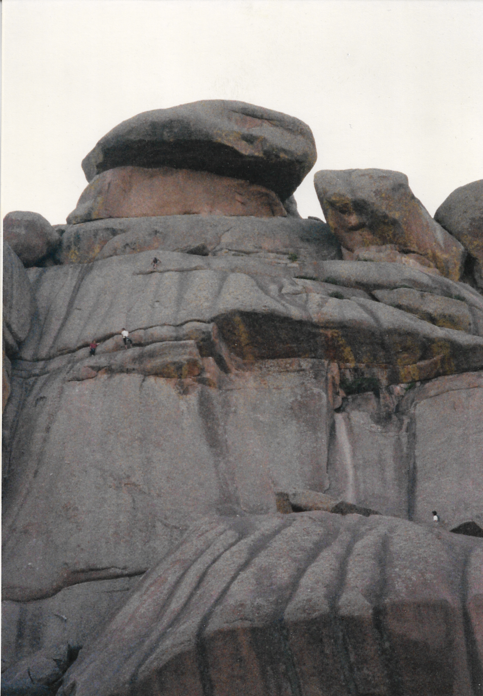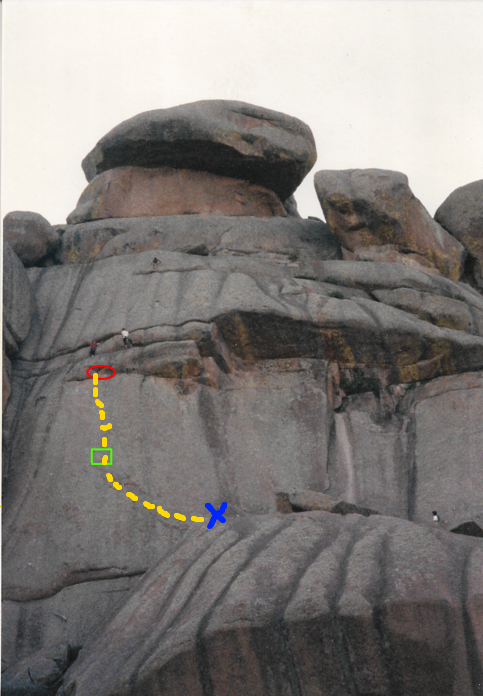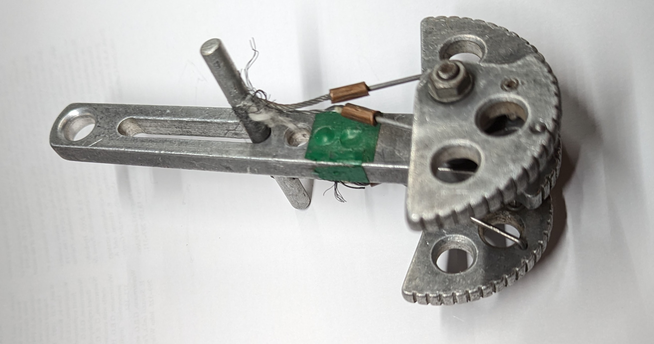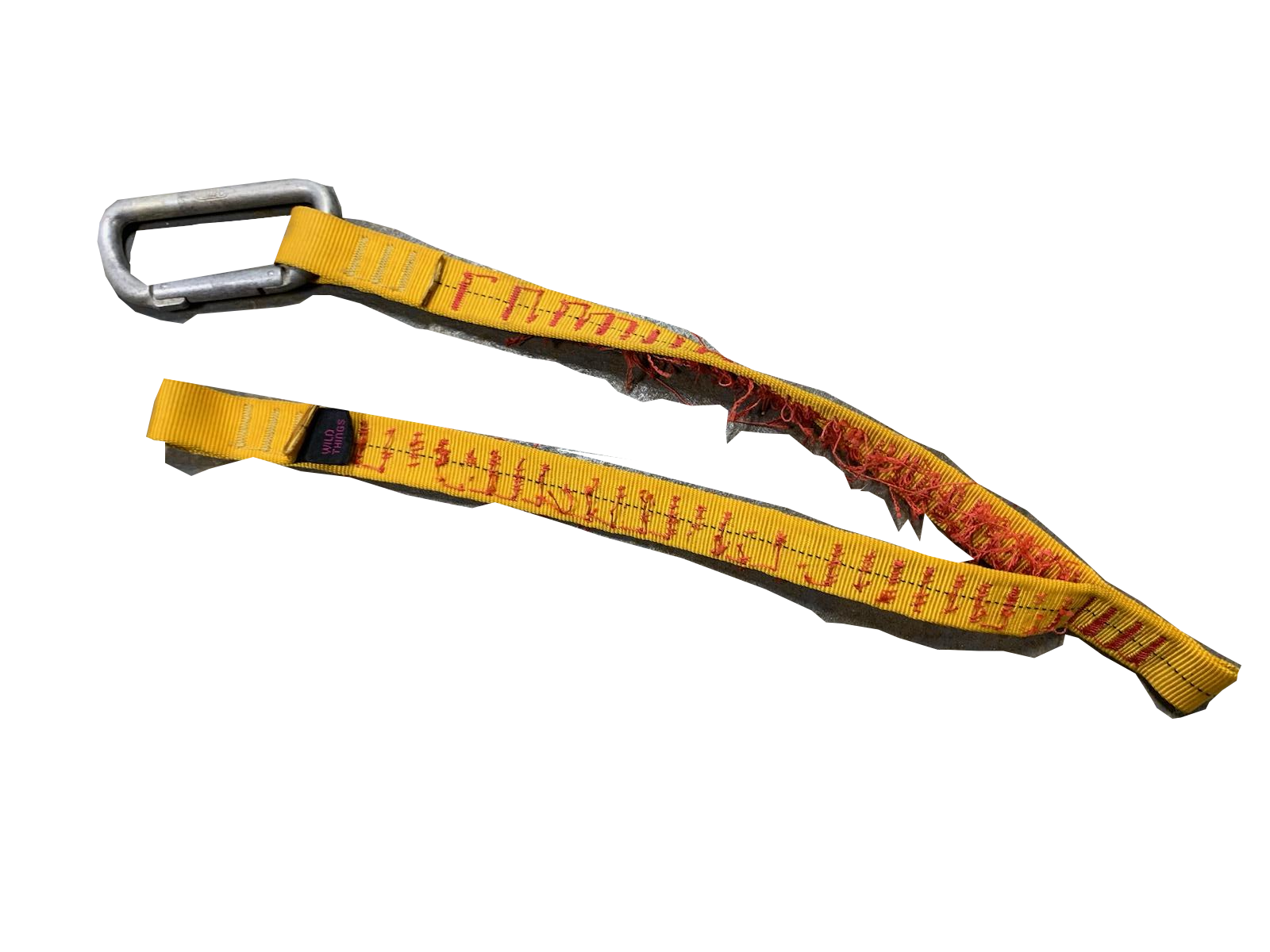Why I Quit Rock Climbing
I was a dedicated rock climber and a sometime ice climber all through the 1980s. I tried to go climbing every weekend, and every holiday.
Here’s why I quit climbing.
I first went rock climbing at Capen Park in Columbia, MO, about 1977 with Boy Scout Troop 25, as part of a caving weekend. Caving was fun, but not as fun as climbing.
It took me a few years to figure out how to get into rock climbing. In May of 1981, I took the Iowa Mountaineers beginning rock climbing class, at Devil’s Lake, near Baraboo, Wisconsin.
My last climb was leading Topographical Oceans, a 5.10 friction climb on The Dome, on one of those fabulously incongruent, warm Colorado winter days in February of 1990.
Between those dates, I had a bad experience that took all the fun out of climbing.
A friend of mine from college, Jay Truesdale, came out to Denver in July of 1989 for a rock climbing trip. We drove up to Wyoming’s Vedauwoo State Park for a multi-day climbing binge. We might have driven up on July 1, it fell on Saturday in 1989.
July 3, 1989, Vedauwoo State Park, Wyoming.
We decided to do Fall Wall a 5.10 face climb, with a small overhang at the top.
Here’s an image of the rock formation that contains Fall Wall (the route), taken by Jay Truesdale:

The person wearing the red shirt (left of the person wearing a white shirt) is at the top of the Fall Wall route. The large block at the bottom of the image with 6 darker stripes on it is roughly the size of a double-wide mobile home. You can scramble to the top of it from off to the right of the picture.
Routes at Vadauwoo are notoriously under-rated, but I was a competent face climber. Vedauwoo’s off-width crack climbs were what I was afraid of.
Here’s a slightly augmented image of the route:

Blue X is where Jay was belaying me. The sloppy yellow dashed line is about where the route lies. There were 3 or 4 bolts and hangers along the route. The small overhang has a red oval marking it.
I made it through the face climbing section, clipping the bolts, the last of which was maybe 8 or 10 feet below the overhang (red oval, above). The face climbing was supposed to be the “crux” of the climb, the hardest part. Climb through the crux and you could breathe easy and top out.
I put a medium-sized Friend (a set of spring-loaded cams that were de riguer for late 1980s rock climbing), in the crack under the overhang.

I think this is that specific Friend.
I set to work figuring out the best way for me to get past the overhang. I finally settled on a pair of small hand holds 6 feet to the right of where I had placed the Friend. Recall that the rope goes from my harness 6 feet to the Friend, then vertically down 10 feet to the top expansion bolt, because as I pulled on the small hand holds, my right hand popped off.
I pendulumed to below the Friend. I heard a metallic ping as it popped out of the crack under the overhang.
I had already fallen 6 feet or so, I had 16 feet of slack rope, and my next lower protection was 4 or feet down. I fell at least 25 feet, probably more like 30 feet with rope stretch and slack between me and my belayer Jay. I ended up at the end of the rope about where the green box is in the picture above. My feet were burning and I hadn’t experienced that much fear since I went skydiving. I got some encouragement from some people down below, something like “you’re still alive, now get back up there and finish the pitch”.

Above is the “Air Voyager” that I had clipped to the top bolt of the pitch. Air Voyagers were simple shock absorbers made by a company named “Wild Things” that now makes tatical military gear. The kinetic energy I developed by falling 25-30 feet ripped out the stitching, as designed.
I winched myself back up to the bolts to recover the carabiners and slings, including the Air Voyager, then Jay lowered me to the ledge. I was beginning to think that maybe I had very badly sprained my ankles. We sat around for a while, the pain in my ankles and feet just got worse.
I limped back to the car, Jay drove back to Cheyenne on I-80. We stopped for dinner at a truck stop called “Little America”. I had chicken fried steak. I was still laboring under the misconception that I had just very badly sprained both ankles.
I don’t remember how I got from the car to my apartment. I didn’t sleep very well that night.
July 4, 1989, Denver, Colorado
I got up took a shower as best I was able, because it was obvious to me that something was very wrong with my feet, and that I was going to be in the hospital at least overnight. I do not remember how I got from my apartment to the car.
Jay drove me to Swedish Medical Center, probably driving right past Porter Hospital on the way.
It turns out that July 4th is a busy day for emergency departments. Since I wasn’t bleeding, I wasn’t a huge priority. A miscarriage, a bicyclist who crashed into fresh asphalt, a firefighter in a stretcher, and a psychotic break all took priority. I sat on a gurney in a hallway feeling lousy.
Sooner or later, they rolled me to the X-ray machine.
Sometime in the late afternoon, an ER doctor came by. I told him I had been rock climbing, I fell, and now both feet and ankles hurt. He flashed a light in my eyes, probably to see if my pupils contracted on both sides.
“Did you hit your head?”
No, i used a climbing rope and all the gear. Didn’t hit the ground.
“Was the rope tied on your feet?”
No, tied to my climbing harness at my waist.
By this time, the on-call orthopedic surgeon has arrived. He sent me back to the X-ray machine, and told me I was going to spend the next few days in the hospital. I got both legs splinted from toes to knees.
After he got the X-Ray films back (1989, remember?), the orthopedic surgeon tells me I’ve cracked the talus bone in my left foot, and a knob on the tibia on the inside of my right ankle. The orthopedic surgeon asks me if I’ve broken my right ankle in the past.
No, but I did sprain it pretty bad in another fall a few years ago.
He tells me I had probably cracked the same knob off my tibia back then. I had just walked it off. I wouldn’t be so lucky this time around.
You climbers and dirt bikers keep me in business he tells me.
He also told me that there was a blood vessel running through the talus bone, and that I stood a chance of losing blood flow to the talus and other parts of my right foot. Luckily, I didn’t rupture that blood vessel, so I didn’t have to find out what it feels like to re-absorb a major bone in your foot and subsequently have difficulty walking.
The Rest of 1989
I got knees-to-toes casts on both legs.
I was in the hospital for four days. My mom drove out from Missouri to take care of me for a few weeks. I went home with a walker, because my balance with rigid casts wasn’t great.
I was really grateful for my mom’s help. She made me get out of the apartment once a day. We went to the Imperial Chinese restaurant in its original location at 1 N Broadway.
My cousin Jon came out from Kansas for a month or so. I’m glad I got to spend that time with him. I had a collection of implements, pieces of wire, a flat, flexible piece of aluminum, a slightly bent table knife, that I used to scratch various parts of my feet. I got my left cast off after 6 weeks, and my right cast off after 9 weeks.
I got a roommate in October of 1989, Tony Bundschu, one of my climbing buddies. He did get me to go out a few times during the fall of 1989, but my heart wasn’t in it.
Also, my feet and ankles would ache. Mid-October, on a Sunday, Tony wanted to go watch a house get moved along Colfax Avenue, east of downtown Denver. It was a 2-story brick house, pulled by a giant truck named “Ol’ Snort” with a crew of maybe 50 workers. A small, informal parade followed it, people were selling burritos out of coolers in little red wagons. A guy that looked like Willie Nelson was in the crowd.
Tony and I walked along with the house, admiring the engineering and organization moving it took. I was super tired that evening, but my ankles were loose the next day, and never ached quite as bad after that.
The house is now at 1515 Race Street in Denver. It’s worth a look.
The next 34 years
I went ice climbing one more time, very early in 1990.
After doing Topographical Oceans, I quit climbing, which meant I was lost for a while. Climbing had motivated a lot of my life, from who I hung out with, to what I ate, and what exercise I did every day.
My feet grew from about size 11 to size 12. I had to get all new shoes. I have some varicose veins on my left foot, under the inside ankle bump.
For the next ten years or so, my feet and ankles would hurt if I got them cold. They also hurt after snowstorms or rainstorms, so not much use for weather prediction. That pain did eventually pass.
I never really had nightmares or anxiety episodes about this particular fall. For a long time, thinking about my October, 1983, misadventure did cause me anxiety and even panic. That was close to the beginning of my decade of rock climbing, so I don’t understand the difference.
